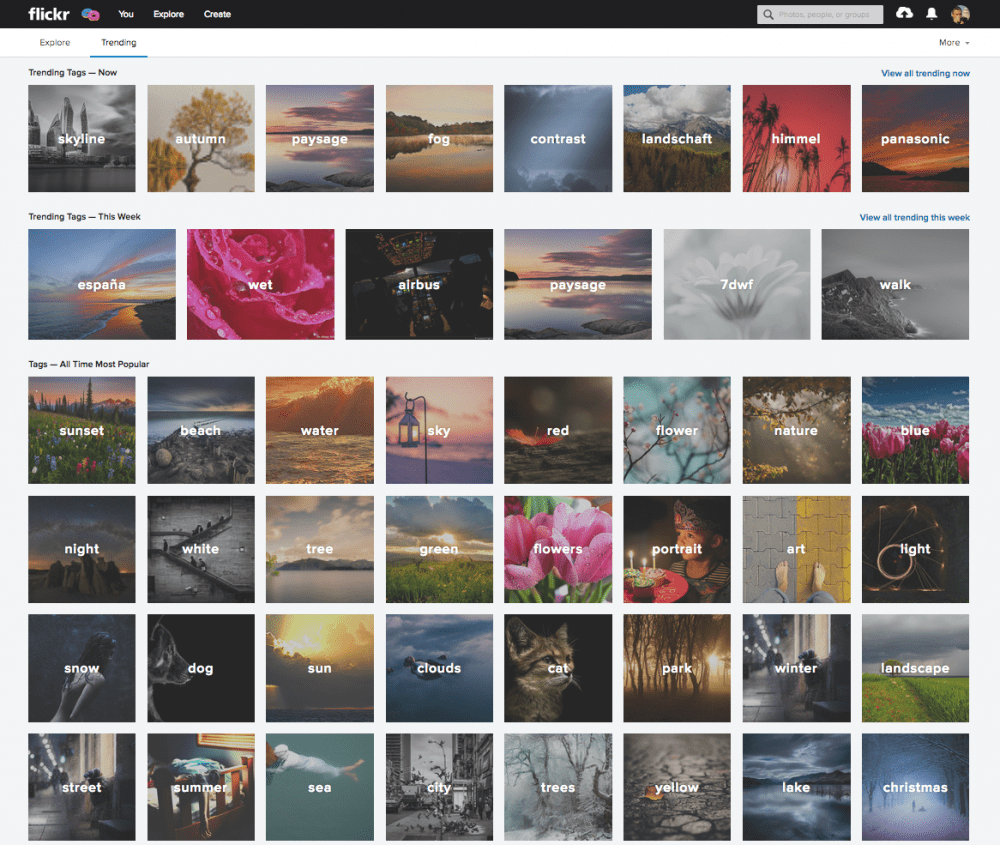Why have you bought Flickr?
We have long admired Flickr as a brand and as a community of very passionate, engaged photographers. So when the opportunity arose, we jumped at it.
Who approached who?
Over the years, we have been in talks with Yahoo many times about various partnerships, and have often told them how much we admire Flickr – so we had already built up a relationship with them. During one of those conversations we were told that Flickr might be outside of the sweet spot for [new Yahoo owner] Verizon’s future direction. We dug into the details and managed to make it happen.
Why was now the right time to purchase Flickr?
I guess they must have decided the time was right. We would have bought Flickr at anytime if we had an opportunity. It was a very complicated deal that took a lot of time and effort to complete, but we’re finally thrilled to get it done.
So many photographers say: ‘I used to use Flickr.’ What went wrong for them?
I’m not sure I have all the answers to that question, partly because I wasn’t there and I have my own business to run. But I think that it’s probably just that Flickr has never been a big focus for Yahoo. They knew they had something great, and luckily they took care of it for all these years, but I’m not sure they ever fully understood it, fully embraced it or fully invested in it. And they never really kept up with the changes that have happened in the world of photography and online services.
But it’s remarkable how big and important Flickr still is. Something like 100 million people use it every month. It is woven throughout the fabric of the internet. The number of external Flickr links embedded on every single platform in the world is just staggering. So while it may not necessarily have thrived as much as everyone wished it would, it certainly hasn’t declined either; it’s just been in a kind of stasis, buoyed up by the deep abiding love of photographers for their community.
Will you keep them as separate brands?
We will keep them as separate brands. We are not planning on merging the two products. We think that both products are awesome for photographers and they both not only offer many different things from each other, but also complement each other quite a bit. So we’ll operate both independently for the foreseeable future.

What are your future plans for Flickr, and what challenges do you face in the immediate future?
I don’t totally know yet what we’re going to do because we’re still learning what works and what doesn’t at Flickr and what Flickr’s community really wants us to build. When we get a sense of what those things are we’ll start building them.
Flickr’s customers have made it loud and clear that they really, really want us to get them off Yahoo’s log-in authentication system, so we are already turning the wheels there and can hopefully make that happen pretty soon. We’ve also heard that people want a free account, and that’s good because we also want that. We think that’s a super-important part of keeping the community thriving and growing.
But in terms of specific new products we might build or the features we might improve on, we don’t know yet – it’s still a little too early. We didn’t acquire Flickr with a big game plan in mind. The Flickr team is extremely talented and they have a good handle on the things they would like to do that they think their community will love, so we’re going to collaborate with them on creating a roadmap that will thrill Flickr customers.
Do you think you’ll be a better custodian of the brand than Yahoo has been?
We’re certainly going to try. I’m optimistic. For 15 years our centre of gravity has been serving photographers, and providing a space where they can tell a story with their photos, so from that point of view our cultures are very well aligned. Certainly more so than when they were part of Yahoo.
What are main points of difference between Smug Mug and Flickr now and in the future plans?
I think it really comes down to the community. If engaging with a big, serious community around your photos within the application is your biggest thing, then Flickr is certainly the answer. If, on the other hand, putting up a beautiful customised website for your family’s photos, a portfolio of your work, or if you’re a working professional who wants our deep e-commerce tools and features then it’s probably SmugMug. There are lots of photographers who want both these things, and I think this is going to be one of the things that will be interesting to figure out: how can we build bridges between the two products, rather than combine them, so they can both continue to be extraordinary at the things they’re extraordinary at, but at the same time make things easier if you want both.
Do you see SmugMug as being more for professionals and Flickr for amateurs?
I don’t know if I’d characterise it that way. We have some of the world’s greatest photographers on SmugMug, but Flickr has some of them too. I think it comes down to what people are looking for. Some people really want their photos to be displayed in a certain way and to be able to really control the access around those photos with privacy controls, and SmugMug is a much better solution for that. But there are a lot of people who want to participate in public with a community of other photographers who shoot similar styles, who really want to learn and grow from looking at the work of others while getting feedback on their own work. And that is just much better at Flickr. Probably two-thirds of SmugMug users don’t make any money from their photography – they are what we call memory makers. They tend to be families and travellers and enthusiasts – people who are into the art and craft of photography.
Do you see Flickr and SmugMug as primarily desktop or mobile apps? Do you have a main focus, and what is the ratio between them?
I think our focus with both platforms is on both. Certainly mobile is growing and exceeding desktop as a consumption mechanism, but I think the photographers to whom SmugMug and Flickr appeal to are looking for a deeper and richer desktop-based experience too, particularly as they are organising their photos. A typical SmugMug or Flickr photographer is likely to have thousands or tens of thousands of photos in their account; they get in there and organise huge quantities of photos so that their friends, family and clients can find the photos they are looking for – I think that requires a large-screen desktop experience to curate. Certainly our subscribers will continue to use both, and once their photos have been curated into albums, stories or collections, I think their visitors will, in large numbers, consume those experiences through their mobile devices.

What are the advantages of using platforms like yours compared with Instagram?
We think there are a number of advantages. The platforms are structured very differently. A platform like Instagram is a wonderful place to showcase your photos, yet you are looking for a quick hit of engagement and a whole bunch of likes and comments for a day, but it’s a very difficult place to tell a long-term story or engage over a long period of time and have some degree of permanence. It’s a place where there is a constant churn on their activity feeds and streams, and photos just don’t have a lot of longevity. People often don’t get to come back and revisit those photos at a later date, and it’s hard to connect a series of photos together to tell a story.
SmugMug and Flickr, on the other hand, are far more structured around allowing users to build something permanent and tell long-lasting stories, and to use the functionality to engage over years and years and know that there is some level of permanence there. All the different products in the space are compelling in their own ways, but ours are more about long-term storytelling rather than short-term engagement ‘in the moment’.
Do you see the main social media platforms as rivals?
I don’t really see them as a problem. Their products and their business model are widely different from ours. They’re very advertiser focused, so most of their effort goes into thinking: ‘How can we sell more and better advertising around people’s photos?’ We just don’t see the world that way. Our photographers are our focus. Our big questions are around how we can build experiences that help people to tell the stories they want to tell to the people they want to tell them to. We don’t have to worry about whether advertisers will like that or not. That’s where my heart is, and where our business is.
With issues around the use of data by social media platforms in the news recently, should your customers have any concerns?
We view our customers uploading their photos to our product as them loaning us their pictures for safekeeping. We don’t look at them and go ‘Great, we’ve got some new data – let’s mine it and see if we can figure out how to sell it to advertisers. It’s just not the way we’re wired. If we’re going to analyse people’s pictures, which we do, it’s so that we can make it easier for them to find their photos of that family trip to Italy, not so that we can sell them products related to Italy.

Don MacAskill, CEO of SmugMug







